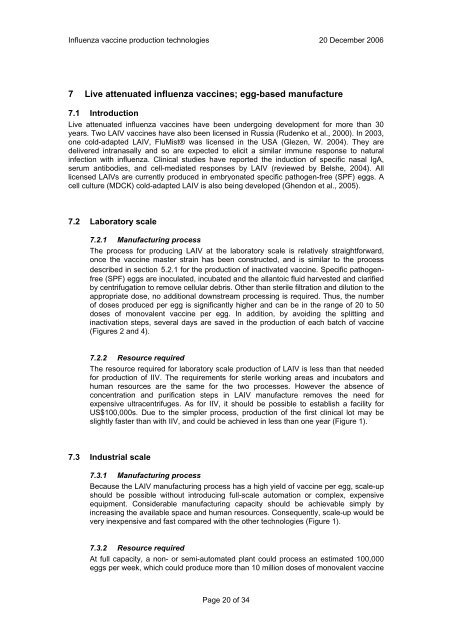A review of production technologies for ... - World Health Organization
A review of production technologies for ... - World Health Organization
A review of production technologies for ... - World Health Organization
Create successful ePaper yourself
Turn your PDF publications into a flip-book with our unique Google optimized e-Paper software.
Influenza vaccine <strong>production</strong> <strong>technologies</strong> 20 December 2006<br />
7 Live attenuated influenza vaccines; egg-based manufacture<br />
7.1 Introduction<br />
Live attenuated influenza vaccines have been undergoing development <strong>for</strong> more than 30<br />
years. Two LAIV vaccines have also been licensed in Russia (Rudenko et al., 2000). In 2003,<br />
one cold-adapted LAIV, FluMist® was licensed in the USA (Glezen, W. 2004). They are<br />
delivered intranasally and so are expected to elicit a similar immune response to natural<br />
infection with influenza. Clinical studies have reported the induction <strong>of</strong> specific nasal IgA,<br />
serum antibodies, and cell-mediated responses by LAIV (<strong>review</strong>ed by Belshe, 2004). All<br />
licensed LAIVs are currently produced in embryonated specific pathogen-free (SPF) eggs. A<br />
cell culture (MDCK) cold-adapted LAIV is also being developed (Ghendon et al., 2005).<br />
7.2 Laboratory scale<br />
7.2.1 Manufacturing process<br />
The process <strong>for</strong> producing LAIV at the laboratory scale is relatively straight<strong>for</strong>ward,<br />
once the vaccine master strain has been constructed, and is similar to the process<br />
described in section 5.2.1 <strong>for</strong> the <strong>production</strong> <strong>of</strong> inactivated vaccine. Specific pathogenfree<br />
(SPF) eggs are inoculated, incubated and the allantoic fluid harvested and clarified<br />
by centrifugation to remove cellular debris. Other than sterile filtration and dilution to the<br />
appropriate dose, no additional downstream processing is required. Thus, the number<br />
<strong>of</strong> doses produced per egg is significantly higher and can be in the range <strong>of</strong> 20 to 50<br />
doses <strong>of</strong> monovalent vaccine per egg. In addition, by avoiding the splitting and<br />
inactivation steps, several days are saved in the <strong>production</strong> <strong>of</strong> each batch <strong>of</strong> vaccine<br />
(Figures 2 and 4).<br />
7.2.2 Resource required<br />
The resource required <strong>for</strong> laboratory scale <strong>production</strong> <strong>of</strong> LAIV is less than that needed<br />
<strong>for</strong> <strong>production</strong> <strong>of</strong> IIV. The requirements <strong>for</strong> sterile working areas and incubators and<br />
human resources are the same <strong>for</strong> the two processes. However the absence <strong>of</strong><br />
concentration and purification steps in LAIV manufacture removes the need <strong>for</strong><br />
expensive ultracentrifuges. As <strong>for</strong> IIV, it should be possible to establish a facility <strong>for</strong><br />
US$100,000s. Due to the simpler process, <strong>production</strong> <strong>of</strong> the first clinical lot may be<br />
slightly faster than with IIV, and could be achieved in less than one year (Figure 1).<br />
7.3 Industrial scale<br />
7.3.1 Manufacturing process<br />
Because the LAIV manufacturing process has a high yield <strong>of</strong> vaccine per egg, scale-up<br />
should be possible without introducing full-scale automation or complex, expensive<br />
equipment. Considerable manufacturing capacity should be achievable simply by<br />
increasing the available space and human resources. Consequently, scale-up would be<br />
very inexpensive and fast compared with the other <strong>technologies</strong> (Figure 1).<br />
7.3.2 Resource required<br />
At full capacity, a non- or semi-automated plant could process an estimated 100,000<br />
eggs per week, which could produce more than 10 million doses <strong>of</strong> monovalent vaccine<br />
Page 20 <strong>of</strong> 34

















